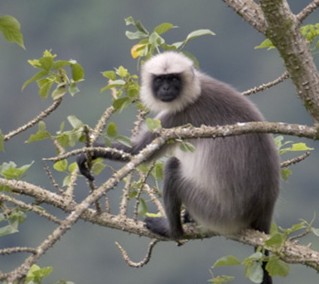- Langoor
Taxobox
name = Gray LangoorsMSW3 Groves|pages=174-175|id=12100693]

image_caption =Black-footed Gray Langoor "S. hypoleucos" from theWestern Ghats
regnum =Animal ia
phylum =Chordata
classis =Mammal ia
ordo =Primate s
familia =Cercopithecidae
subfamilia =Colobinae
genus = "Semnopithecus"
genus_authority = Desmarest, 1822
type_species = "Simia entellus"
type_species_authority = Dufresne, 1797
subdivision_ranks = Species
subdivision = "Semnopithecus schistaceus" "Semnopithecus ajax" "Semnopithecus hector" "Semnopithecus entellus" "Semnopithecus hypoleucos" "Semnopithecus dussumieri" "Semnopithecus priam"The gray Langoors are a group of
Old World monkey s and make up the entirety of thegenus "Semnopithecus".Gray Langoors are large and fairly terrestrial, inhabiting open wooded habitats and urban areas on the
India n subcontinent. Until recently they were considered one species, "Semnopithecus entellus"; now seven distinct species are recognized. [cite journal|author=Osterholz, Martin;Walter, Lutz and Roos, Christian|title=Phylogenetic position of the Langoor genera Semnopithecus and Trachypithecus among Asian colobines, and genus affiliations of their species groups|journal=BMC Evolutionary Biology|volume=8|year=2008|issue=1|pages=58|url=http://www.biomedcentral.com/1471-2148/8/58|doi=10.1186/1471-2148-8-58] When only one species was recognized, it was also called the Hanuman Langoor (named after theHindu vanara divinityHanuman ), the Common Langoor and the Entellus Langoor. InSri Lanka , it is natively known as the Wandura.Description
They are largely gray, with a black face. In Indian mythology, this is because Hanuman, a monkey warrior, burnt his hands and face trying to rescue Lord Rama's wife. Males are up to 75 cm long, and females 65 cm. Langoors from the southern part of their range are smaller than those from the north.
Diet
Gray Langoors feed on leaves, fruit, buds and flowers. Their diet, however, is highly seasonable, with mature leaves being eaten only as a fall-back food during the winter months. In the summer, especially before the monsoon season, they are highly
frugivorous . They also supplement their diet with insects (up to 25% in some months), tree bark and gum.Behavior and reproduction
Though they sleep in trees, they spend more time on the ground than any other known colobine species. They are diurnal and usually walk on all fours.
They live in medium to large groups, usually with one dominant male. Males do not hold the dominant position for long in a group, with the average being about 18 months. Adolescent males who are expelled from the group sometimes form 'bachelor' packs. These packs, after a time, start to harass the group that expelled them, and challenge the alpha for leadership of the pack. If an attack by a bachelor pack is successful and they are able to kill the alpha, they will engage in a power struggle, where first all of the infants fathered by the previous alpha are killed, and then the bachelors fight among themselves, killing each other until only one remains, who then becomes the leader of the pack.
An interesting relationship has been observed between herds of
Chital deer and troops of theNorthern Plains Gray Langoor ("S. entellus"), a widespread leaf-eating monkey of South Asia. Chital apparently benefit from the Langoors' good eyesight and ability to post a lookout in a treetop, helping to raise the alarm when a predator approaches. For the Langoors' part, the Chital's superior sense of smell would seem to assist in early predator warning, and it is common to see Langoors foraging on the ground in the presence of Chital. The Chital also benefit from fruits dropped by the Langoors from trees such as "Terminalia bellerica ".Alarm call s of either species can be indicative of the presence of a predator such as theBengal Tiger .fact|date = September 2007pecies list
*
Nepal Gray Langoor , "Semnopithecus schistaceus"
*Kashmir Gray Langoor , "Semnopithecus ajax"
*Tarai Gray Langoor , "Semnopithecus hector"
*Northern Plains Gray Langoor , "Semnopithecus entellus"
*Black-footed Gray Langoor , "Semnopithecus hypoleucos"
*Southern Plains Gray Langoor , "Semnopithecus dussumieri"
*Tufted Gray Langoor , "Semnopithecus priam"References
External links
* [http://pin.primate.wisc.edu/factsheets/links/semnopithecus Primate Info Net "Semnopithecus" Factsheets]
Wikimedia Foundation. 2010.
